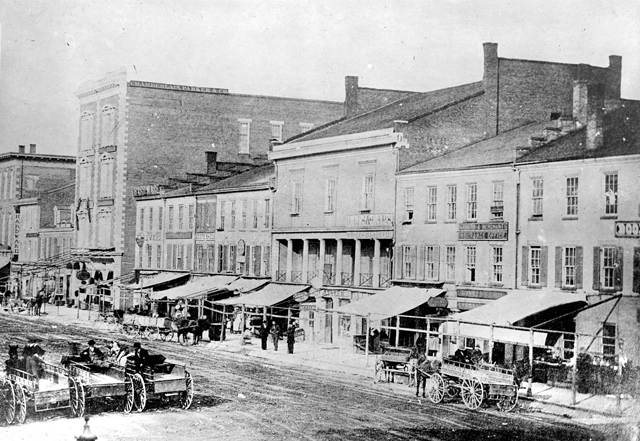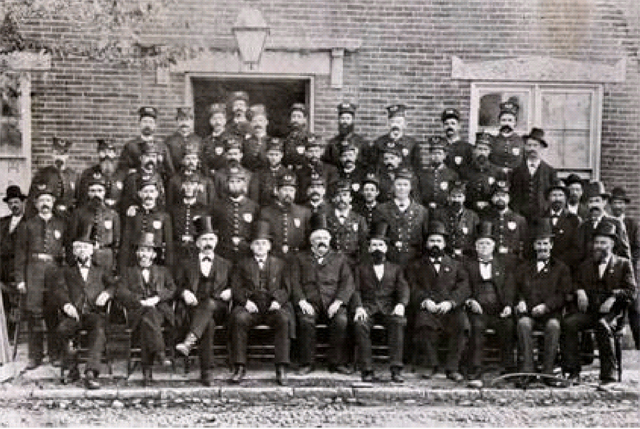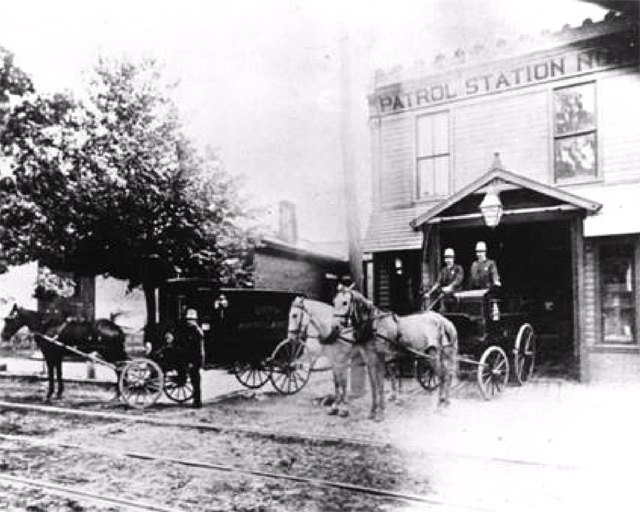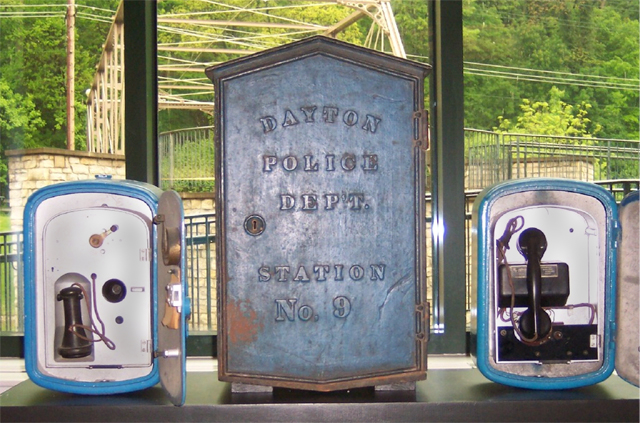From Settlement through Civil War
1796 – 1866

Buildings on Main Street opposite Old Court House circa 1850s
Dayton was settled in 1796 in a river wilderness on the western edge of the frontier. The new community was meager… five families. The foundation of local police service began with the appointment of the first constable, Cyrus Osborn, on June 10, 1797. Newcom Tavern, built by Colonel George Newcom – one of Dayton’s original settlers – at the corner of Main Street and Monument Avenue, served as the new town’s courthouse and jail.
1803 was a significant year, in that Ohio was granted statehood, Montgomery County was formed, and Colonel Newcom was appointed as the first sheriff. The following year, a log jail was built at the northwest corner of Third and Main Streets, replacing the use of Newcom Tavern for this purpose. On February 12, 1805, the town of Dayton was incorporated; the first charter designated the position of town marshal whose duty was to keep the peace. In 1805 James Miller was appointed the first marshal at a salary of $25.00 per year.
The first walking patrol beat assignment came in 1833, when Joseph L. Allen was paid by local individuals to be a watchman on patrol of the designated square. Every half-hour, Allen walked from the courthouse at Third and Main Streets to Jefferson Street, then to Second Street and back to the courthouse.
When Dayton was granted a city charter on December 29, 1840, its population exceeded 6,000 with a police “force” consisting of one marshal assisted by watchmen and citizens when called upon. By 1848, Dayton’s population had grown to 10,000. The police force had also increased to include six watchmen who assisted the marshal, a deputy marshal, and two constables who performed patrol and law enforcement duties.
After a rash of burglaries that occurred in the mid-1850s, the city council authorized the mayor and the marshal to appoint as many as four watchmen for each of the six city wards to patrol during emergencies. The watchmen would receive $2.00 for every 24-hours of service.
Formation of the Dayton Police Force
1867 – 1884

First Photo of the Dayton Police Force 1876
Following the Civil War, many former soldiers viewed police work as a logical way to use the skills they developed during the war. On April 22, 1867, a police force was formed, consisting of a “captain and acting superintendent”, two sergeants and twenty officers to cover a city with a population of more than 25,000. This new metropolitan police force was to last only one year as new legislation returned the city to the old marshal form of policing.
On March 29, 1873, the Ohio General Assembly passed a law creating a Board of Police Commissioners, placing into effect what had previously been dissolved. What is now the Dayton Police Department was officially established.
In the early days, patrolmen were assigned to 12-hour work shifts, with two-thirds of the force working the night shift. Foot patrol was essentially the only method of patrol used, with the exception of the occasional horse. The department did not even have a wagon to use for patrol.
In 1873, patrolmen received $840.00 annually, and were expected to purchase their own uniforms and equipment. Weapons, such as clubs and guns, were not issued as they are today; instead they were the personal property of the individual patrolman.
In 1883, when Dayton had grown to more than 38,000 residents, the police force purchased its first horse-drawn patrol wagon.
Infancy of the Dayton Police Force
1885 – 1899

First Patrol Station located at 15 Brown at Fifth Street 1883
In the early years, there was some political interference in the operations of the Dayton Police Force. In an attempt to change this, the Ohio General Assembly reorganized the force in 1887. The police force was placed under control of a “non-partisan” Board of Commissioners, whose members were first appointed by the Governor. The board consisted of four commissioners, two appointed from each political party, with the mayor serving as an ex-officio member.
During this time, uniforms began to look less like the military style seen in the years following the Civil War. Canes became a popular piece of equipment for officers. The peeler-style hat, similar to those worn by English Bobbies, became the common style worn in Dayton.
As Dayton continued to grow – having 61,000 residents by 1890 – the police force grew as well, increasing to 68 officers. In addition to the increase in manpower, a second patrol wagon that would also serve as an ambulance was added to the force.
New patrol methods had been added by the late 1890s, including both a bicycle patrol and a mounted unit. This added an increased mobility to the police force to allow it to patrol a city that had increased 25% in size in just one decade.
Gamewell System and Police Call Boxes
1896 (in operation until 1967)

Dayton Police Call Boxes
In 1896 Dayton purchased and placed into operation the Gamewell System of police telegraph. The $25,000 system consisted of 64 patrol boxes strategically located around the city. The telegraph feature remained the primary identifying function. When the “hook” was pulled, a telegraph signal would transmit the call box number (i.e. box location) to the central “exchange” where it would imprint the number on a paper ticker tape.
In 1896, the Gamewell system was considered the greatest modern improvement in police service delivery. The system had an “exchange” operator 24 hours a day. The operator could take complaints and information over the telephone and then relay this information to patrolmen when they checked in. Patrolmen assigned to their walking beat were required to do so every hour.
In 1901, the Red Light Signal System was purchased at a cost of $2,500 as an enhancement to the Gamewell telegraph system. At the time, this was considered another significant advancement in police communications and service response.
Red lights were located on telegraph/telephone poles at 12 “stations” around the city. When the lights were turned on by central exchange, all patrolmen were to contact headquarters from a call box or telephone to receive instructions. On-duty walking beat patrolmen had to be alert to watch for the red light signal on the pole because, when illuminated, patrolmen had 15 minutes to respond to the signal. The Gamewell system lasted nearly 50 years as a primary method of dispatching officers to calls.
Dayton police began modifying some of its call boxes with “modern” telephone receivers circa 1945. The telegraph system had become an obsolete method of communication with the change to the retrofitted police call box.
By 1957, the number of call boxes throughout Dayton had reached 99 in number, far more than the 74 in operation in 1920 and a third more than the 64 originally installed in 1896. By 1967, only a few police call boxes had functional phones inside. In the early 1970’s, the new portable radio dispatch system that was instituted made call box communications an exercise of the past. Slowly the boxes were removed from poles and turned into scrap metal. A number of call boxes, and call box parts, were salvaged by police officers.
Return to Dayton Police History Home Page